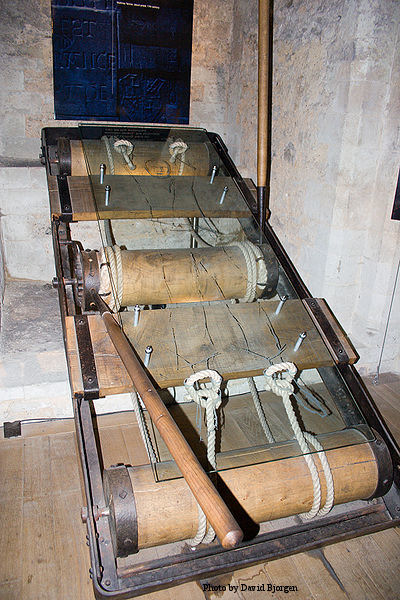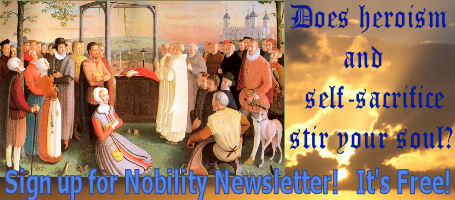Blessed Christopher Bales
The Rack. Richard Topcliffe, a Member of Parliament during the reign of Elizabeth I of England, was a fanatical persecutor of Catholics and the Church. He became notorious as a priest-hunter and torturer and was often referred to as the Queen’s principal “interrogator”. He claimed that his own instruments and methods were better than the official ones and was authorized to create a torture chamber in his home in London.
Priest and martyr, b. at Coniscliffe near Darlington, County Durham, England, about 1564; executed 4 March, 1590. He entered the English College at Rome, 1 October, 1583, but owing to ill-health was sent to the College at Reims, where he was ordained 28 March, 1587.
Sent to England 2 November, 1588, he was soon arrested, racked, and tortured by Topcliffe, and hung up by the hands for twenty-four hours at a time; he bore all most patiently. At length he was tried and condemned for high treason, on the charge of having been ordained beyond seas and coming to England to exercise his office. He asked Judge Anderson whether St. Augustine, Apostle of the English, was also a traitor. The judge said no, but that the act had since been made treason by law.
He suffered 4 March, 1590, “about Easter”, in Fleet Street opposite Fetter Lane. On the gibbet was set a placard: “For treason and favouring foreign invasion”. He spoke to the people from the ladder, showing them that his only “treason” was his priesthood. On the same day Venerable Nicholas Horner suffered in Smithfield for having made Bales a jerkin, and Venerable Alexander Blake in Gray’s Inn Lane for lodging him in his house.
[ed. note: He was beatified 15 December, 1929, by Pope Pius XI]
Bridgewater, Concertatio Ecclesiae Catholicae in Anglia (Trier, 1589); Challoner, Memoires; Pollen, Acts of English Martyrs (London, 1891); Northern Catholic Calendar; Knox, Douay Diaries (London, 1878); Morris, Catholics of York under Elizabeth (London, 1891); Foley, Records S. J.; Roman Diary (London, 1880).
BEDE CAMM
Blessed Nicholas Horner
Layman and martyr, born at Grantley, Yorkshire, England, date of birth unknown; died at Smithfield, 4 March, 1590. He appears to have been following the calling of a tailor in London, when he was arrested on the charge of harbouring Catholic priests. He was confined for a long time in a damp and noisome cell, where he contracted bloodpoisoning in one leg, which it became necessary to amputate. It is said that during this operation Horner was favoured with a vision, which acted as an anodyne to his sufferings. He was afterwards liberated, but when he was again found to be harbouring priests he was convicted of felony, and as he refused to conform to the public worship of the Church by law established, was condemned. On the eve of his execution, he had a vision of a crown of glory hanging over his head, which filled him with courage to face the ordeal of the next day. The story of this vision was told by him to a friend, who in turn transmitted it by letter to Father Robert Southwell S.J., 18 March, 1590.
Horner was hanged, drawn and quartered because he had relieved and assisted Christopher Bales, seminary priest and martyr, b. at Cunsley, Durham, 1564, d. on the Scaffold at Fetter Lane, London 4 March, 1590. Father Bales was cruelly tortured in prison, although he was a consumptive; and was condemned merely for being a priest.
GILLOW, Bibl. Dict. Eng.. Cath., s. v.; CHALLONER, Memoirs, (Edinburgh, 1878), I, 166, 169, 218; RIBADENEIRA, Appendix Schismatis Anglicani (1610), 25; MORRIS, Troubles, 3rd series.
C.F. WEMYSS BROWN
cfr. Catholic Encyclopedia



No comments:
Post a Comment